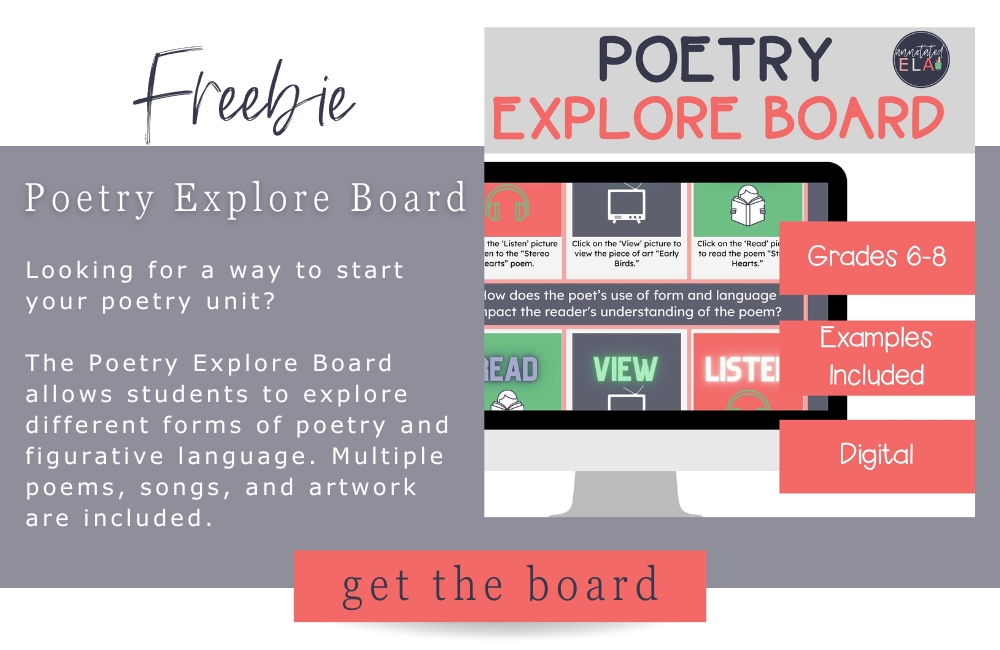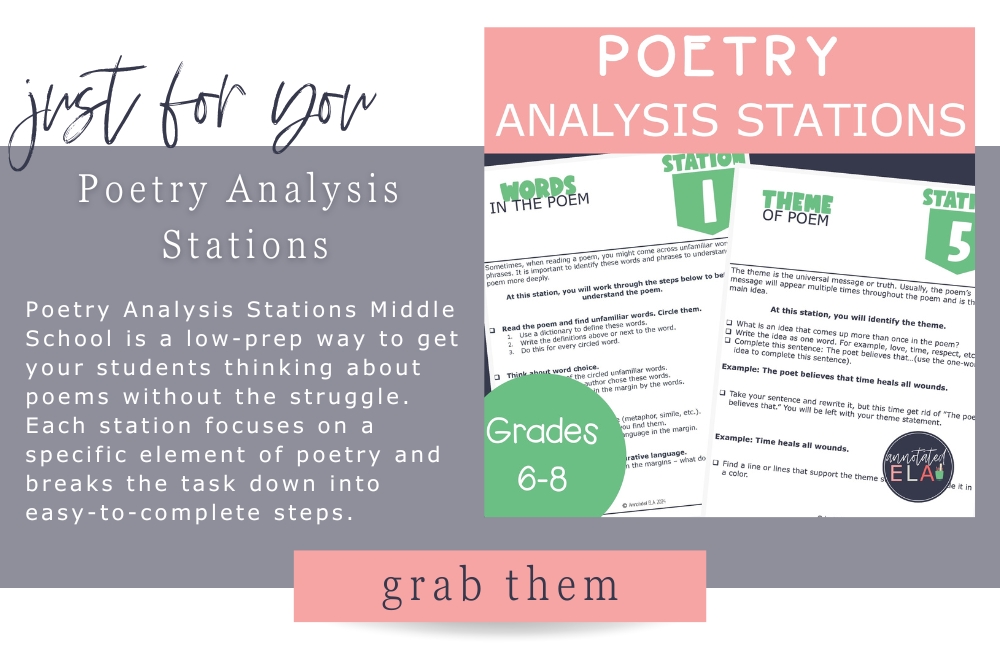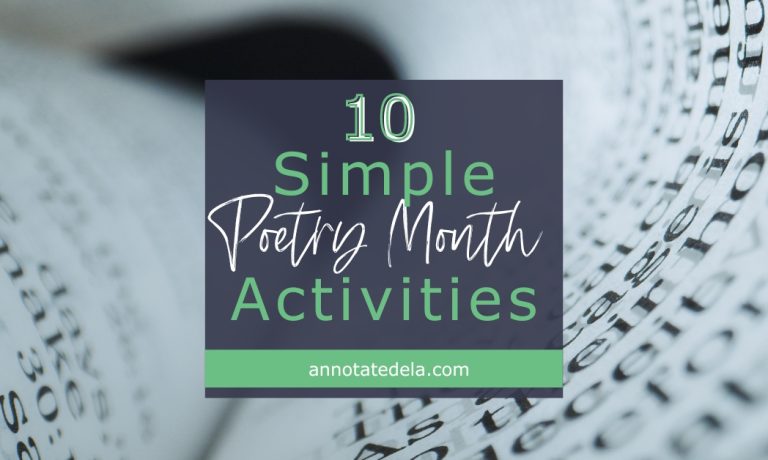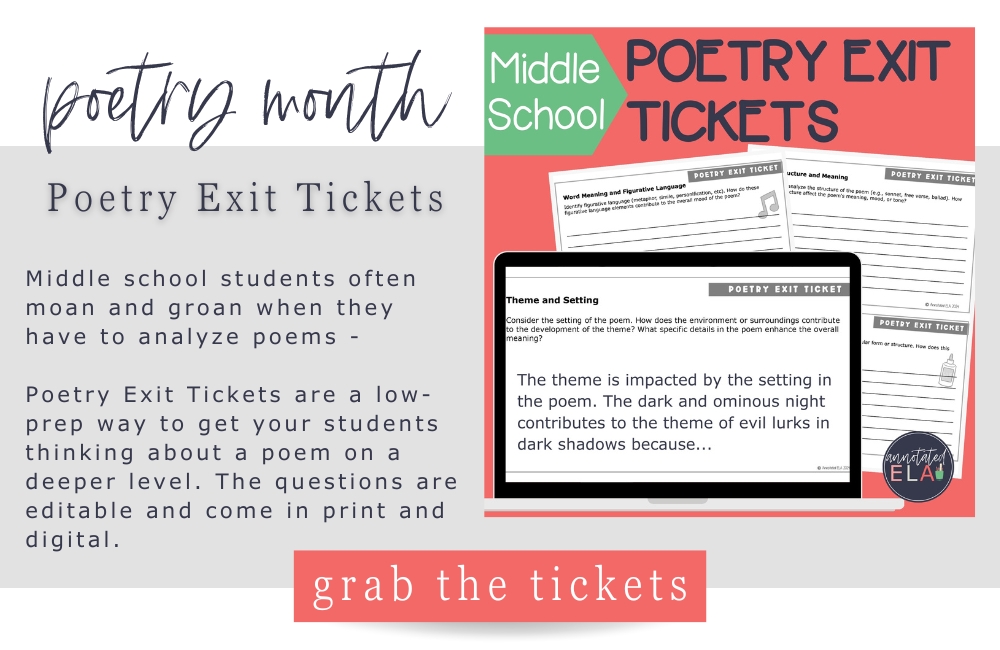In celebration of Poetry Month, I have crafted a list of poetry month activities aimed at fostering a deeper appreciation for poetry.
Is your classroom feeling a bit… prosy? Dust off those anthologies and get ready to unleash a month-long exploration of lyrical language and rhythmic revelry.
From scavenger hunts to picture books your students are sure to fall in love with poetry, or at least give it a chance. So grab your rhyming dictionaries and prepare to paint the town (or classroom) red… with ink, of course.
Buckle up, because these poetry month activities are about to take your students on a tour of the world of poetry!
Poetry Month Activities #1: Poem a Day
Begin Each Day/Class Period with a New Poem. Starting the day or class with a new poem can spark curiosity and set the tone for creativity, critical thinking, and an appreciation for language.
It will also expose students to diverse voices and styles, igniting discussions and introducing themes for deeper exploration. This quick ritual can shift perceptions of poetry as something accessible and impactful. Looking for inspiration to help you plan for 30 poems or even a poem a week? Check out the Poetry Exit Tickets.
Another great resource for finding poems is on poets.org with their “Poems for Kids.”
Poetry Month Activities #2: Poetry Book/Novels in Verse List
Team up with your colleagues or the media specialist to curate a tempting reading list of poetry books. Post the list around the school, in your classroom, online, anywhere students will see it and want to take notice.
After making the list, have the books in a prominent place. This is why connecting with your media specialist is key when planning poetry month activities. Take it a step further and read a preview of the books on the list once a week in March and April.
A poetry reading list, caters to varied interests with different genres, formats, and authors. This encourages independent reading, exposes students to hidden gems, and builds a classroom culture that celebrates poetry beyond the textbook.Check out my blog, Twenty Engaging and Relatable Novels in Verse for Middle Grades to see a curated list of novels in verse that might interest your students.
Poetry Month Activities #3: Favorite Poem
Engaging students in a scavenger hunt to discover and share their favorite poems encourages active participation and exploration. It promotes peer learning and exposes students to different tastes and perspectives in poetry.
Make it simple by setting up stations in your classroom, the hallway or around the school where students rotate through and read different poems. They rate the poems at each station and at the end the students choose their favorite and explain why.
Of course, teachers can also create a “true” scavenger hunt and unleash student detective skills! Hide poem snippets around the school or online, providing clues to their location and meaning. This playful activity gets students physically and mentally engaged, fostering collaboration and creative interpretation.
Poetry Month Activities #4: Explore Board
Developing an Explore Board, either physically or digitally, allows students to visually engage with various poetic elements, themes, and notable poets.
Pin up intriguing questions, recommended poems, author biographies, and visual prompts. This encourages independent exploration, allows students to curate their own learning journey, and fosters a vibrant classroom conversation about poetry.
Grab your FREE Poetry Month Activities Explore Board.

Poetry Month Activities #5: Teach This Poem
Sign Up for Teach This Poem on the poets.org website.
Sign up for “Teach This Poem,” a free resource providing insightful lesson plans and engaging activities for specific poems. This platform provides diverse materials to enrich students’ understanding and analysis of poems.
This takes the guesswork out of teaching challenging poems, offering ready-made tools to spark class discussions, deepen understanding, and build student confidence.
Poetry Month Activities #6: Picture Books with Figurative Language
Exploring picture books rich in figurative language serves as a bridge for students to understand complex poetic devices in a more accessible format. It encourages critical thinking and deepens comprehension of literary techniques.
It also provides an opportunity to discuss similes, metaphors, and personification through colorful illustrations and playful rhymes. This childlike approach reminds students of the joy and immediacy of poetry, making it easier to connect with complex concepts.
Picture Book Suggestions
The Sound of Silence by Katrina Goldsaito
This book uses beautiful descriptive language to explore the power of silence and the beauty found in quiet moments. It’s a poetic story about a boy discovering the sounds of Tokyo and the importance of listening. It is a longer picture book, so I suggest choosing specific pages to analyze.
The Dark by Lemony Snicket and Jon Klassen
Lemony Snicket’s language in this book is rich with metaphors and personification, telling the story of a boy’s conversation with the dark. Jon Klassen’s illustrations complement the text beautifully.
The Night Gardener by Terry Fan and Eric Fan
This book uses lyrical language and enchanting illustrations to tell the story of a young boy’s discovery of a magical night gardener who transforms his drab town into a lush wonderland.
Grandpa Green by Lane Smith
Through poetic language and whimsical illustrations, this book explores the life of a boy’s great-grandfather, using a garden as a metaphor for memories and the passage of time.
Zen Shorts by Jon J. Muth
This book weaves Eastern philosophy and storytelling together through the tales of a giant panda named Stillwater. The stories, filled with vivid imagery and deep wisdom, encourage thoughtfulness and reflection.
Journey by Aaron BeckerA wordless picture book, Journey takes readers on a fantastical adventure through breathtaking illustrations. It’s a tale of imagination, creativity, and the power of art to transform one’s world. Although there are no words, this would be a chance for students to practice imagery by writing about the beautiful scenes on each page.
These books not only offer engaging narratives but also use vivid and descriptive language, enabling middle schoolers to explore and appreciate the nuances of figurative language in storytelling.
Poetry Month Activities #7: Illustrate a Poem
Choose a poem for the class to do, provide options for poems that have been read, or allow students to choose their own poem. However students get the hands on poems, giving them the opportunity to illustrate the poem taps into their creativity and improves comprehension.
Encouraging students to illustrate their favorite poems fosters creativity and a deeper understanding of the poem’s imagery and themes. It combines visual with literary interpretation, allowing for a multi-sensory experience.
This visual expression helps them internalize the poem’s meaning, fostering deeper connections and allowing them to see poetry through a new lens.
Poetry Month Activities #8: Poem in Your Pocket
Participating in Poem in Your Pocket Day promotes a sense of community and shared appreciation for poetry. It encourages students to select and carry a poem, fostering spontaneous discussions and connections throughout the day.Students can share poems aloud, create pocket-sized booklets, or simply reflect on the chosen words. This portable poetry experience strengthens the personal connection to poetry and sparks spontaneous joy.
Poetry Month Activities #9: Poetry Analysis Stations
Setting up stations for poetry analysis encourages critical thinking and collaboration. Stations also cater to diverse learning styles.
Each station could have a different poem, but I prefer to have the students analyzing one poem for all the stations. This allows for a whole class reading and discussion before and after stations.
Set up stations around the classroom with different poetry analysis activities. Students can rotate through stations focusing on elements of poetry.
Possible Poetry Analysis Station Topics:
Structure & Form
Meter
Rhyme and Rhyme Scheme
Sound & Rhythm
Symbol
Speaker
Figurative Language & Poetic Devices
Theme
Tone & Mood
Syntax
Want ready-made poetry analysis stations for any poem? I have your back, check out my Poetry Analysis Stations for any Poem – Middle School.

Poetry Month Activities #10: Create a Poetry Anthology
Compiling an anthology of favorite and original poems empowers students to showcase their creativity and literary appreciation. It culminates in a tangible project that reflects their understanding of poetry and all that has been learned throughout the month.
Decorate it, share it with the school community, and celebrate the powerful voices within your classroom. Have fun with poetry!
By incorporating these simple poetry month activities, you can turn Poetry Month into a dynamic and engaging experience for your secondary students. Each of these activities aims to benefit students by fostering creativity, critical thinking, appreciation for literature, and collaborative learning while making poetry engaging and accessible in the classroom.
Let your students discover the magic of words, the power of expression, and the joy of reading and creating poetry with these ten poetry month activities!





One Response